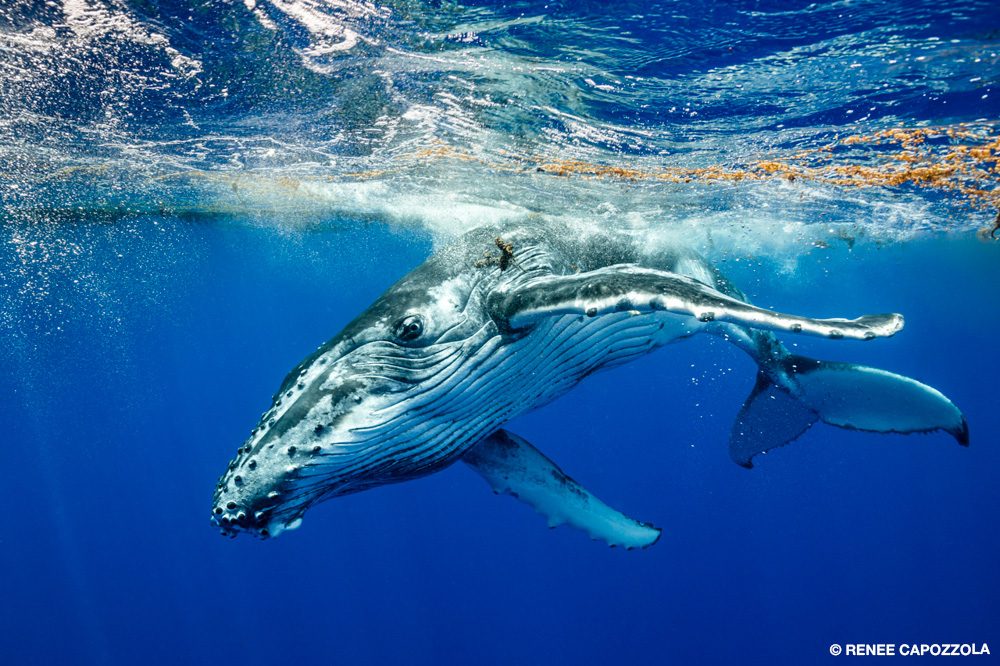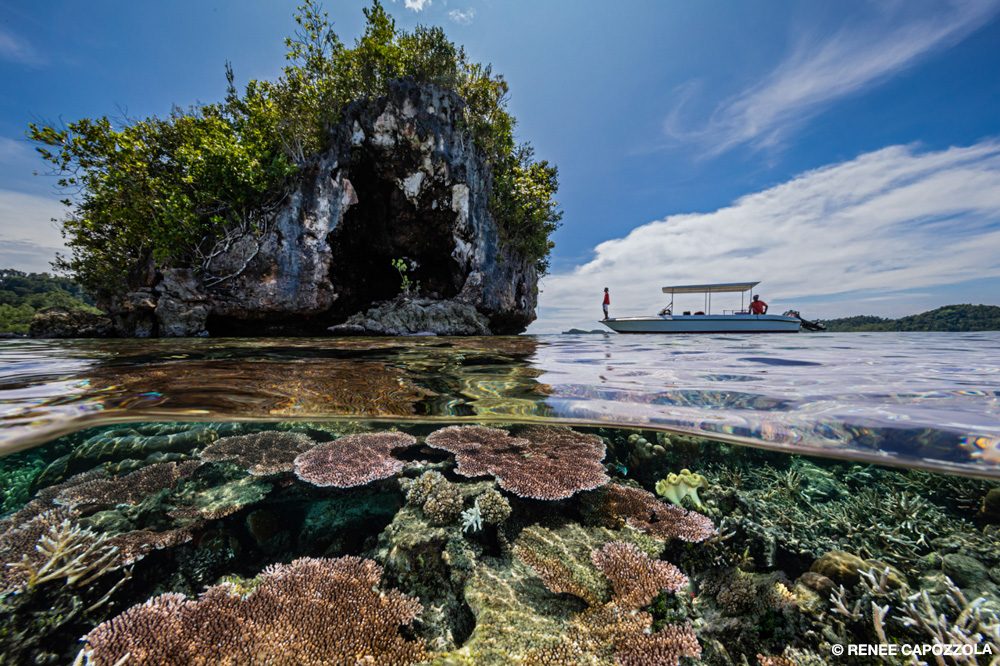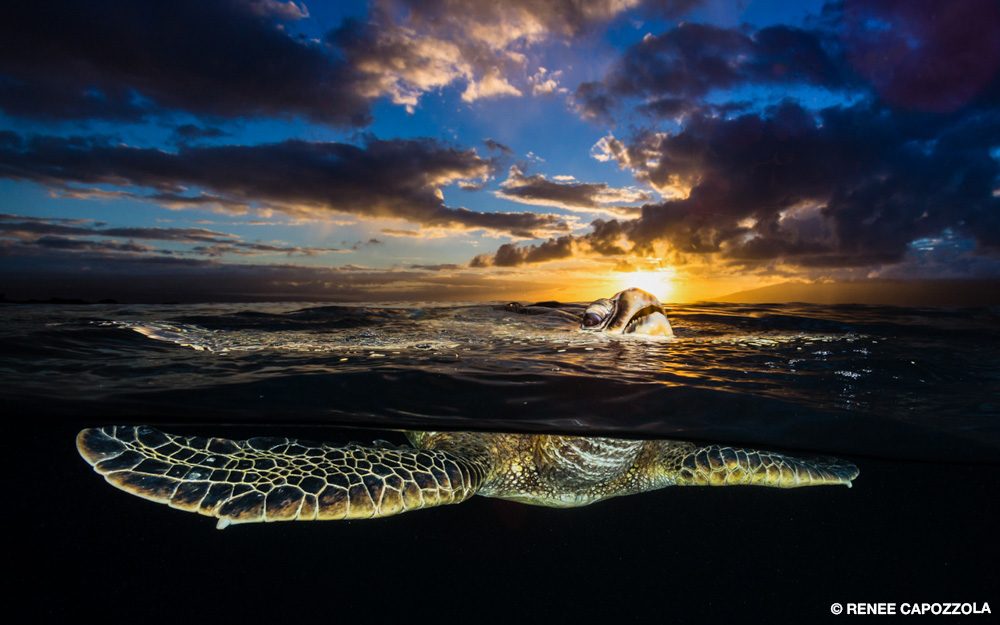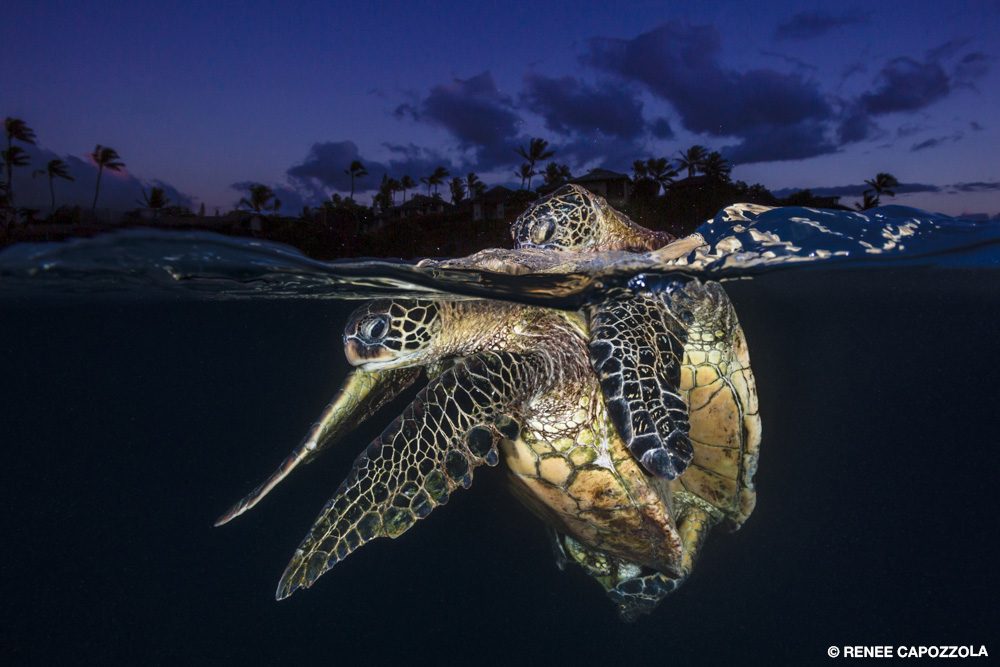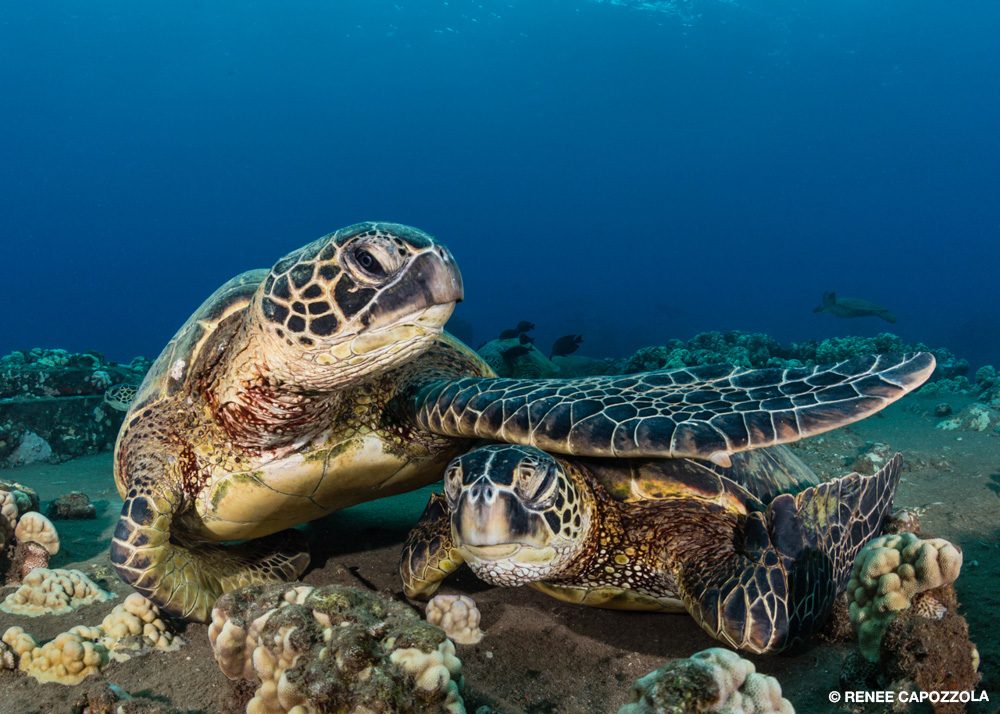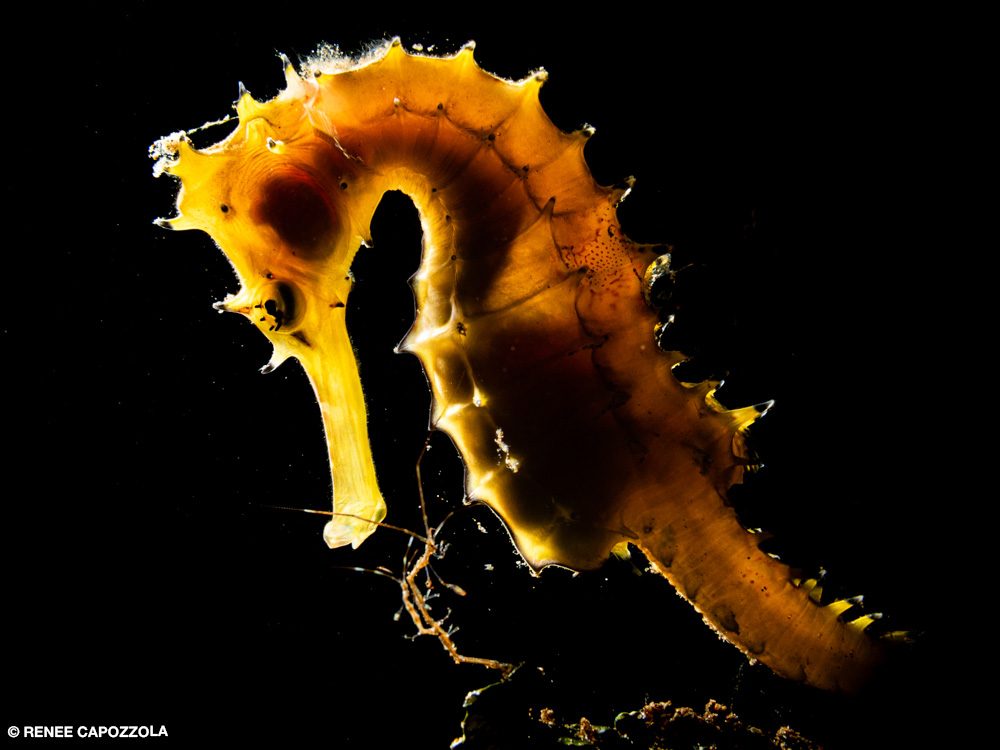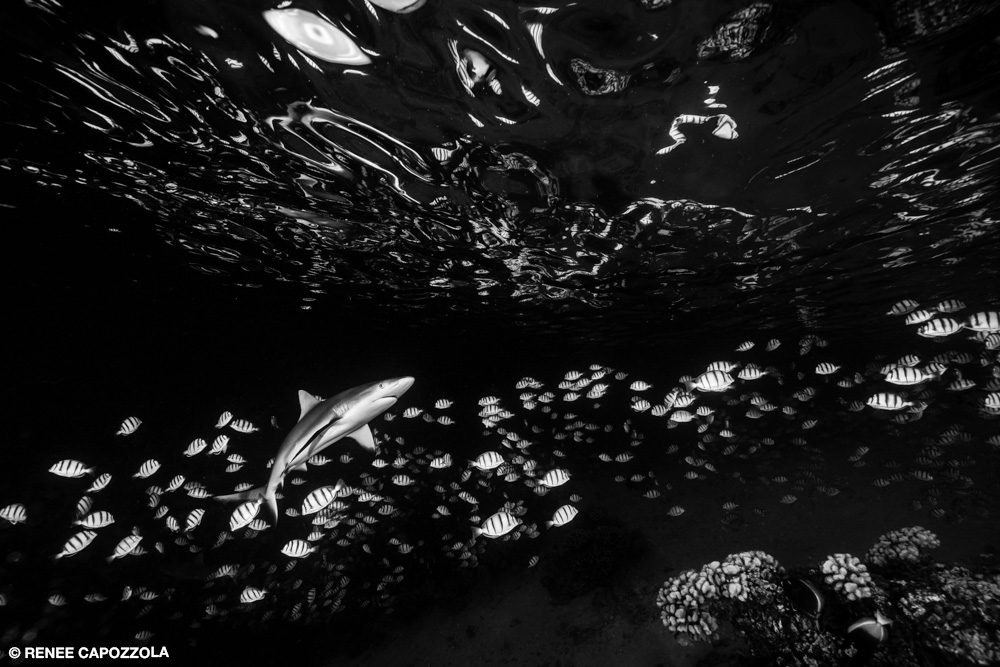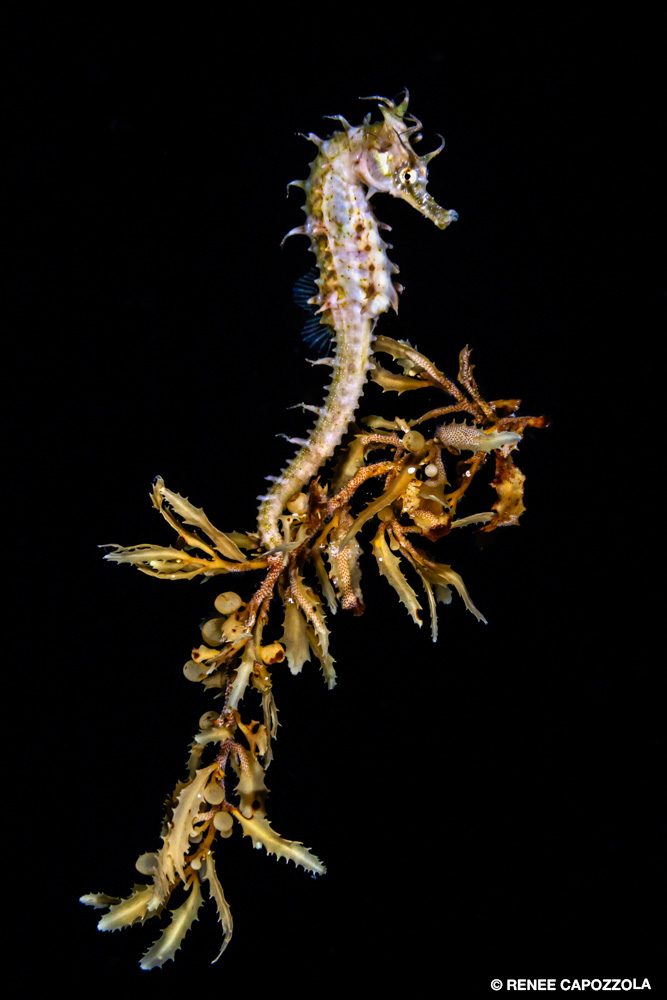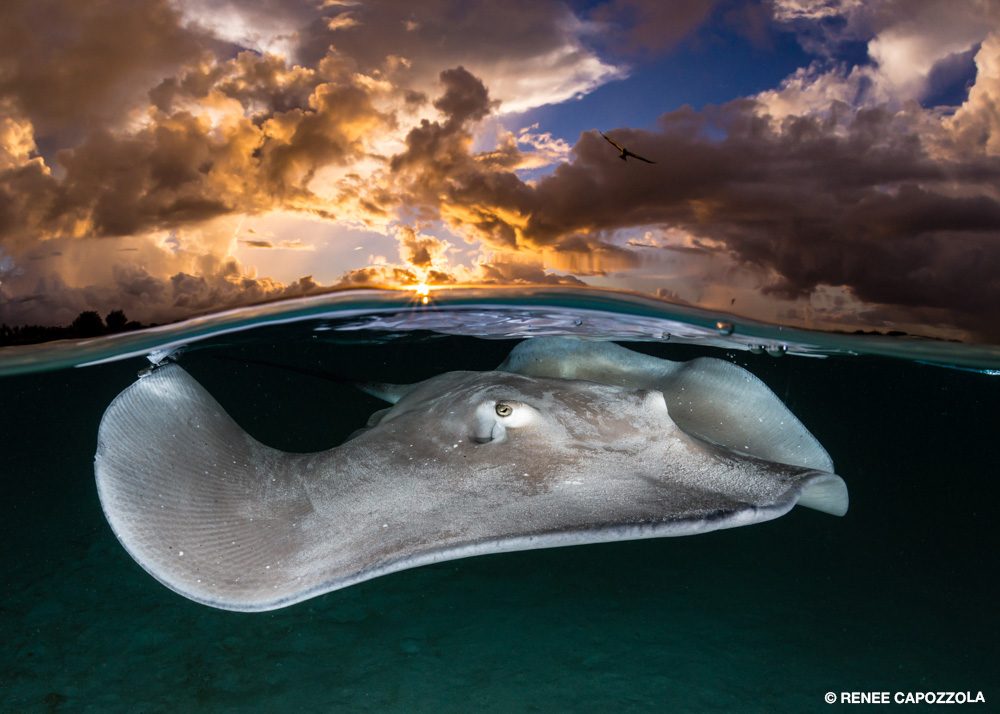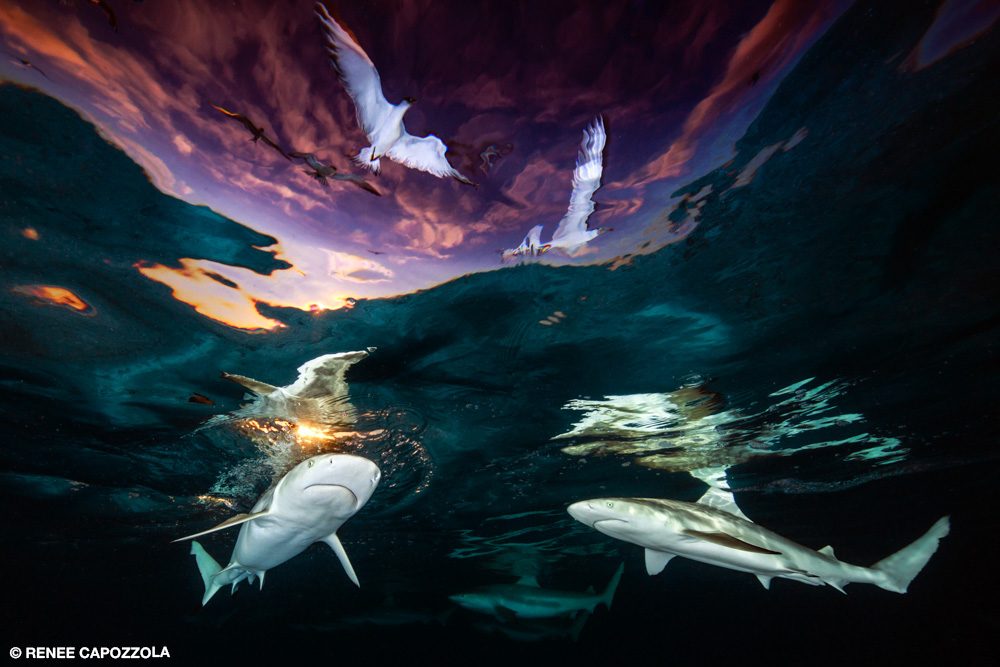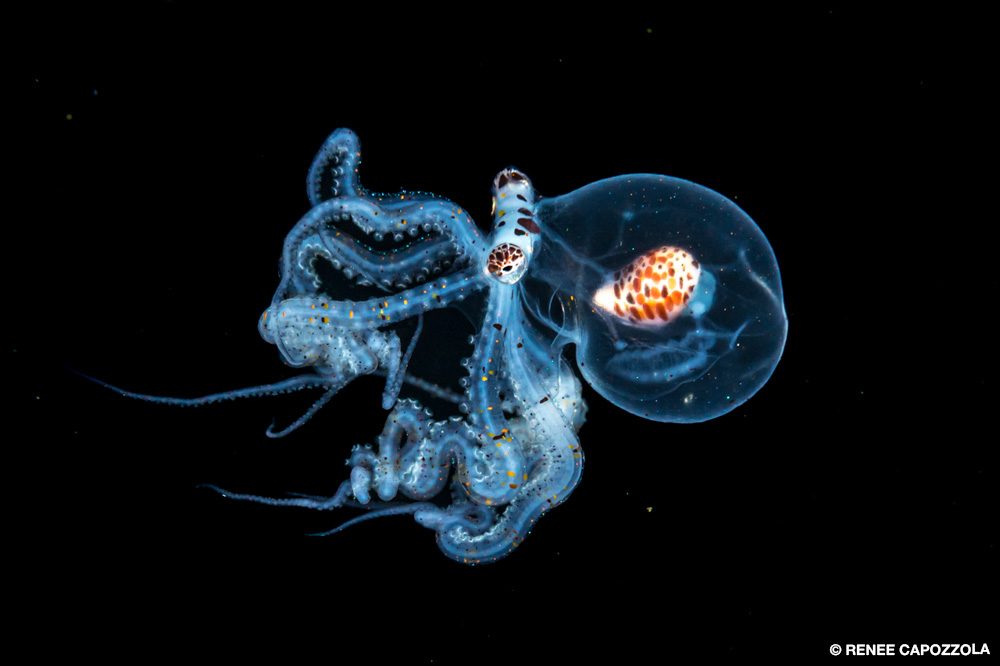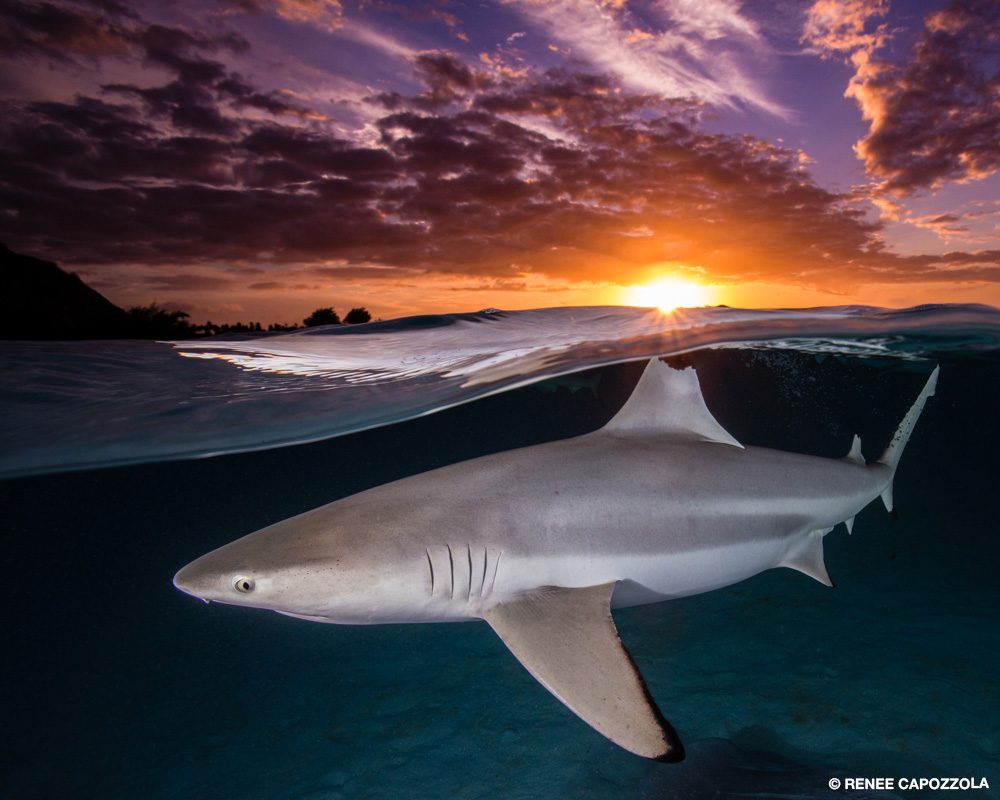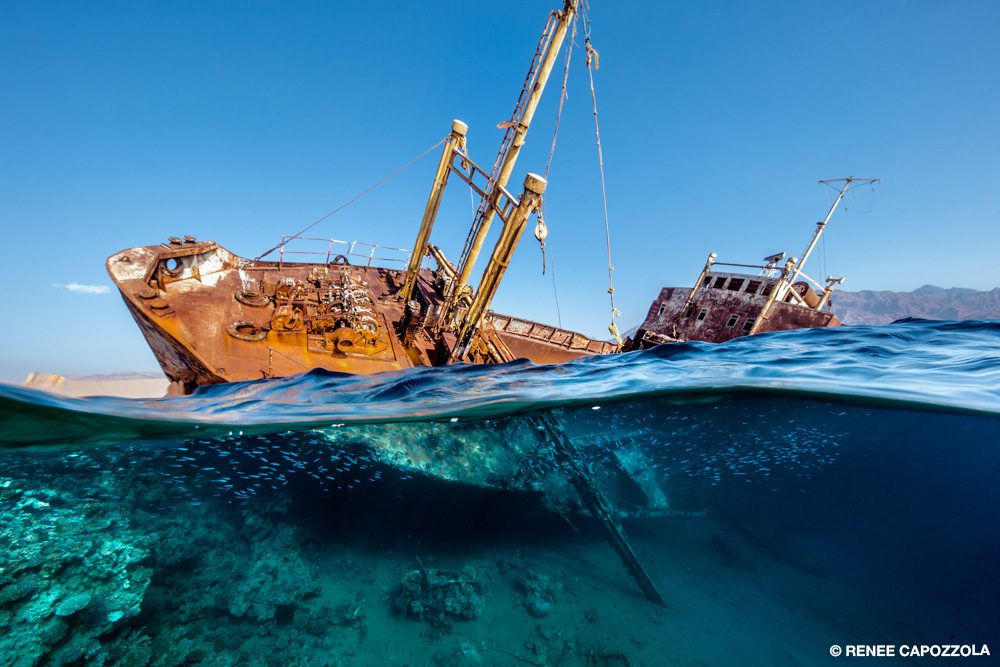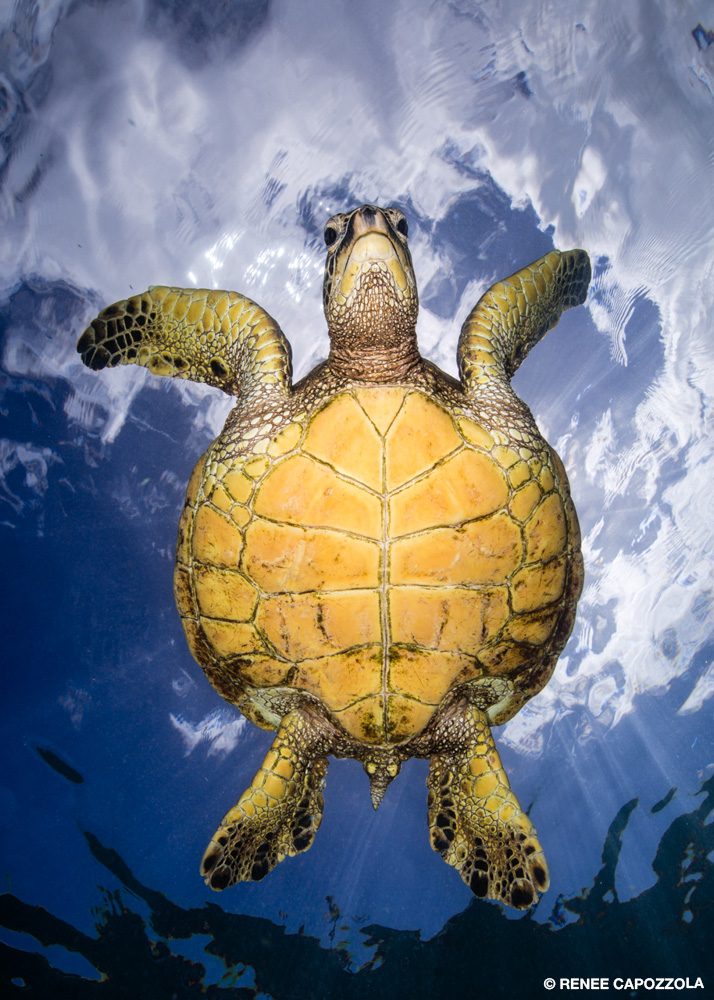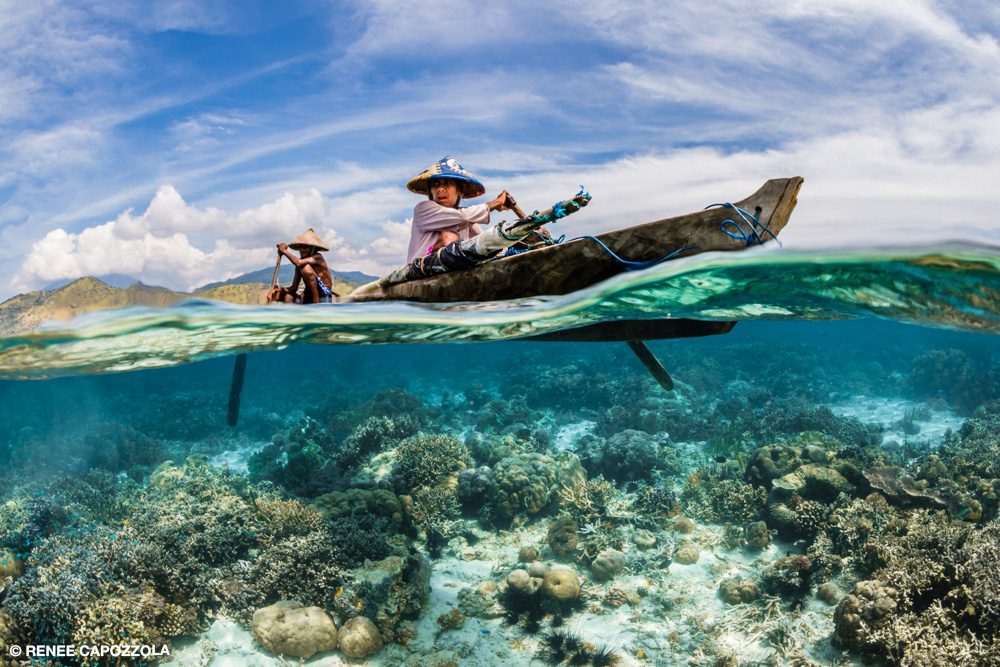THE ROUTE TO PROMINENCE IN UNDERWATER PHOTOGRAPHY is varied and constantly evolving. For a long time it was measured primarily in books or magazine articles published or the catalog of clients for underwater product illustrations. With the emergence of digital media, the number of followers a photographer has on a social media platform has grown in significance.
Success in high-profile photo contests has also become an increasingly prestigious and credible pathway. There is validation in consistently being chosen number one by your peers, along with the extraordinarily wide viewership the winners’ portfolios enjoy on social media. No one has navigated that niche with greater aplomb than Renee Grinnell Capozzola. Her images being consistently recognized as the best of the best speaks to her strategic planning, vision, and technical execution.
Renee picked her preferred specialty, the half-and-half (over-under) photograph, and used that as her hammer to drive the nail home in those early competitions. Her images have won more than 50 prestigious international accolades, some of which include first place in the 2022, 2020, and 2017 Ocean Geographic Pictures of the Year, first place in the 2021 and 2019 United Nations World Oceans Day Photo Competition, first place in the 2018 Big Picture: Natural World Photography Competition, and the Best in Show award at 2017 Beneath the Sea. She was a member of the U.S. national team that won the global championship in the 2016 and 2019 World ShootOut.
One of her most significant honors was being recognized by Blancpain in 2021 for the Female Fifty Fathoms (FFF) award as part of the Oceanographic Magazine Ocean Photography Awards. Also in 2021, she was chosen Underwater Photographer of the Year by the appropriately named Underwater Photographer of the Year (UPY) competition, honoring a single image of excellence: “Sharks’ Skylight” is an underwater Snell’s window shot of a pair of blacktip reef sharks at sunset with gulls visible through the water. The UPY’s head judge, Alex Mustard, reflected on what elevated this one image above the 4,500 other entries: “This is a photograph of hope, a glimpse of how the ocean can be when we give it a chance…. The photographer not only persevered until this serendipitous scene unfolded, but more important, Renee had the talent to capture this precise moment.”
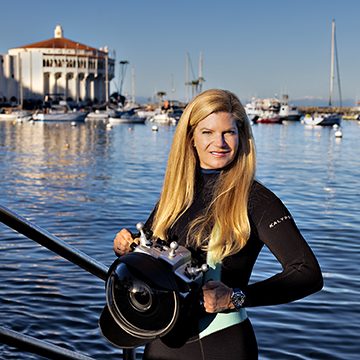
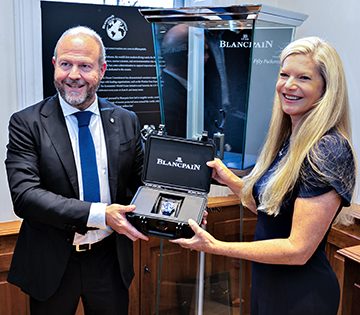
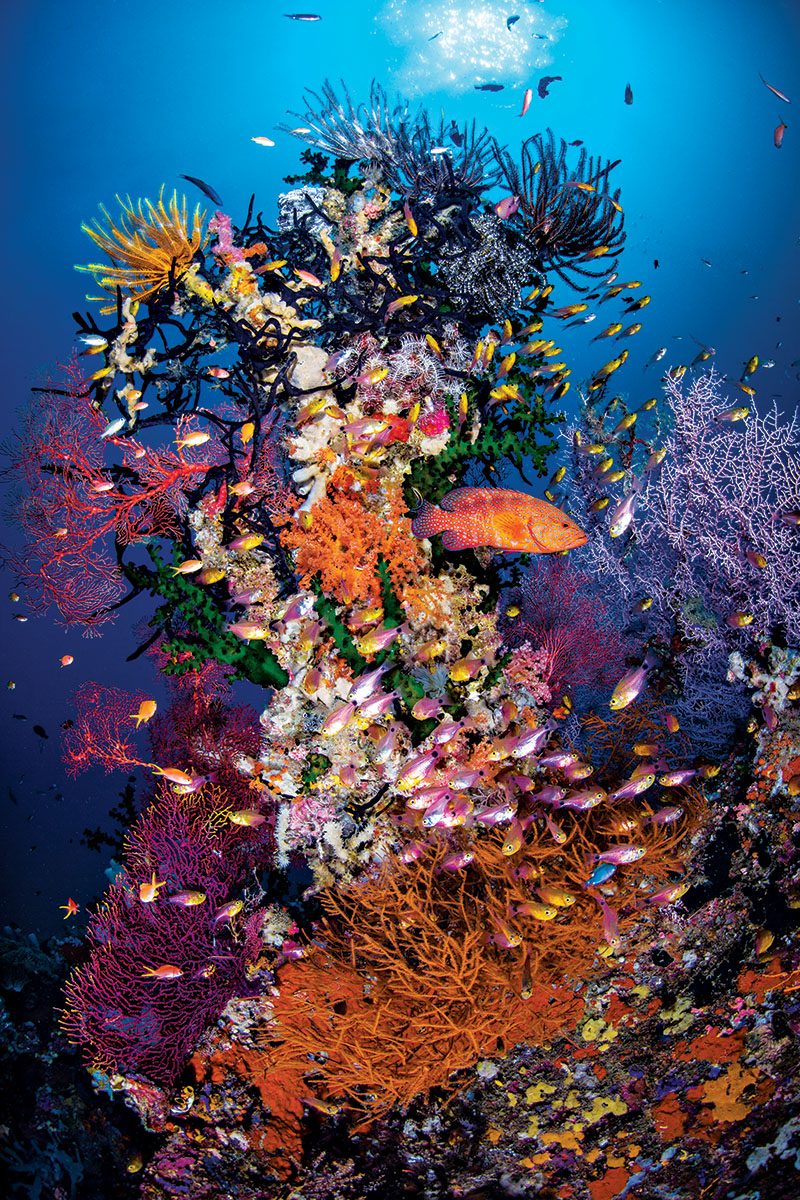
For all the attention Renee’s photography has received in the past decade, her beginnings in underwater photography were inauspicious. She grew up in Southern California, and her father was an airline executive, so the short five-hour flight to Hawai‘i was their family’s island getaway. She recalls walking down Front Street in Lahaina, Maui, as a child and seeing the art galleries by Wyland and Christian Riese Lassen.
The fantasy scenes with marine life below and an exotic seascape above were particularly enchanting and inspired her to begin painting when she was just 7 years old. She took that craft very seriously; even in her college years she spent an entire year working in excruciating detail on a moonlit-night half-and-half scene with dolphins.
The underwater world of scuba diving eluded her, even as she traveled with her husband, Damian, to destinations including Italy and Hawai‘i. She remembers sitting in a hotel room in Lahaina and reading a tourist booklet titled 101 Things to Do in Maui. One suggestion was SNUBA, an underwater breathing protocol where the air supply is in a support raft on the surface and connects to the diver’s regulator by a long hose. Getting an intimate view of the reef on SNUBA motivated the couple to try a PADI Discover Diving course. This initial exposure to diving permanently set the hook: Renee and Damian stopped snow skiing and going to Europe and instead began planning how and where to do their next dives.

They couldn’t spend all their time traveling, however, because Renee had a full-time job that wasn’t underwater photography. She has a master’s of physical therapy degree and worked in sports medicine for five years, but the manipulations were hard on her wrists, so she started teaching Advanced Placement biology and anatomy/physiology at Palos Verdes High School in California. Family demands also grew with the 2007 and 2011 births of her children.
She began her journey into underwater photography around that time, but her equipment was limiting for the first decade of her pursuits. She had only a Sony Cyber-Shot point-and-shoot camera. With its digital lag, limited optics, and minimal strobe options, she couldn’t perform to the level of her aspirations. In 2013 she upgraded to a Canon PowerShot G10 for available light and added a pair of strobes the next year.
While her gear was limiting, her imagination was unbridled. Renee read all the books she could find on underwater photography. Her favorite was David Doubilet’s pivotal Water, Light, Time (although she might have added “and a good camera” to the title if she had written it). She learned more photo techniques from Martin Edge’s The Underwater Photographer. At seminars offered by Bluewater Photo in Culver City, California, she became friends with inspirational underwater shooters Ron Watkins, Andy and Allison Sallmon, and Mark Strickland.


All her learning and practice laid the foundation for her career’s explosive growth in 2016, when she finally upgraded to the digital single-lens reflex (SLR) Canon EOS 5D Mark III, a Nauticam housing, and her go-to wide-angle lenses: the Canon 16-35mm and Tokina 10-17mm. The addition of a pair of Sea and Sea YS-D1 strobes brought her into the equipment mainstream. She continued to tweak her preferences and has recently evolved to using a Canon 5D Mark IV in a Seacam housing, and she is recognized as one of Seacam’s highly esteemed brand ambassadors.
As an aside, I asked Renee why she preferred the digital SLR over the new mirrorless Canon R5. She pointed out that much of her work is from small boats in remote locations, and she sometimes spends five hours in the water working on one series of images. The DSLR’s longer battery life was the deciding factor for her.
“I’m not a fan of the electronic viewfinder on the mirrorless systems, especially when shooting into the sun,” she added. “The battery life is about more than longevity — I prefer an 11-24mm lens for my half-and-half shots, which requires taking off the port and lens from the front and removing the camera from the housing to change batteries. This process is very cumbersome when I’m on a boat all day and the camera is wet.”


Renee now travels the world in pursuit of her underwater photos — she dived Raja Ampat last year with her son and just returned from Antarctica. In the early years though, she remained true to her West Coast getaway of Hawai‘i and became especially proficient at photographing the green sea turtles she encountered there.
She became a master of light in the half-and-half discipline, blending the ambient light of dusk and the setting sun with the kiss of strobe light to add color and detail in the split frame’s underwater portion. As she continued to perfect the process, she expanded the subject portfolio to include stingrays and blacktip reef sharks in French Polynesia. These were the images that launched her success.
The one image that jump-started everything for her is the one she calls “Sharky Sunset.” It is the main image for which she received the Blancpain FFF award and the first to make a splash in international photo contests. It exemplifies her approach to working with a singular subject and executing a vision; her talent and perseverance paid off in a big way.
As her career continues to evolve, she has embraced new and creative genres of underwater photography. Recently in Anilao, Philippines, she recommitted herself to blackwater photography, expanding on the work she began in Kona, Hawai‘i, in 2018 and pursued further in Anilao and Lembeh over the next year. This dedication paid off with first place in the 2020 Beneath the Sea macro category. This past winter she went to Antarctica to expand her portfolio with coldwater subjects.
While the half-and-half image has been her trademark, her vision continues growing ever more eclectic. AD
© Alert Diver — Q2 2023
EXPLORE MORE
See more of Renee Capozzola’s work at beneaththesurfaceimaging.com
